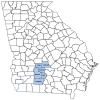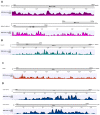Persistent, and Asymptomatic Viral Infections and Whitefly-Transmitted Viruses Impacting Cantaloupe and Watermelon in Georgia, USA
- PMID: 35746780
- PMCID: PMC9227350
- DOI: 10.3390/v14061310
Persistent, and Asymptomatic Viral Infections and Whitefly-Transmitted Viruses Impacting Cantaloupe and Watermelon in Georgia, USA
Abstract
Cucurbits in Southeastern USA have experienced a drastic decline in production over the years due to the effect of economically important viruses, mainly those transmitted by the sweet potato whitefly (Bemisia tabaci Gennadius). In cucurbits, these viruses can be found as a single or mixed infection, thereby causing significant yield loss. During the spring of 2021, surveys were conducted to evaluate the incidence and distribution of viruses infecting cantaloupe (n = 80) and watermelon (n = 245) in Georgia. Symptomatic foliar tissues were collected from six counties and sRNA libraries were constructed from seven symptomatic samples. High throughput sequencing (HTS) analysis revealed the presence of three different new RNA viruses in Georgia: cucumis melo endornavirus (CmEV), cucumis melo amalgavirus (CmAV1), and cucumis melo cryptic virus (CmCV). Reverse transcription-polymerase chain reaction (RT-PCR) analysis revealed the presence of CmEV and CmAV1 in 25% and 43% of the total samples tested, respectively. CmCV was not detected using RT-PCR. Watermelon crinkle leaf-associated virus 1 (WCLaV-1), recently reported in GA, was detected in 28% of the samples tested. Furthermore, RT-PCR and PCR analysis of 43 symptomatic leaf tissues collected from the fall-grown watermelon in 2019 revealed the presence of cucurbit chlorotic yellows virus (CCYV), cucurbit yellow stunting disorder virus (CYSDV), and cucurbit leaf crumple virus (CuLCrV) at 73%, 2%, and 81%, respectively. This finding broadens our knowledge of the prevalence of viruses in melons in the fall and spring, as well as the geographical expansion of the WCLaV-1 in GA, USA.
Keywords: Georgia; USA; cantaloupe; cucumis melo amalgavirus (CmAV1); cucumis melo cryptic virus (CmCV); cucumis melo endornavirus (CmEV); persistent virus; watermelon; watermelon crinkle leaf-associated virus 1 (WCLaV-1).
Conflict of interest statement
The authors declare no conflict of interest.
Figures



Similar articles
-
Prevalence of Aphid-Transmitted Potyviruses in Pumpkin and Winter Squash in Georgia, USA.Viruses. 2025 Feb 8;17(2):233. doi: 10.3390/v17020233. Viruses. 2025. PMID: 40006988 Free PMC article.
-
High Throughput Sequencing-Aided Survey Reveals Widespread Mixed Infections of Whitefly-Transmitted Viruses in Cucurbits in Georgia, USA.Viruses. 2021 May 26;13(6):988. doi: 10.3390/v13060988. Viruses. 2021. PMID: 34073397 Free PMC article.
-
Development of a multiplex RT-RPA assay for simultaneous detection of three viruses in cucurbits.Mol Plant Pathol. 2023 Nov;24(11):1443-1450. doi: 10.1111/mpp.13380. Epub 2023 Jul 18. Mol Plant Pathol. 2023. PMID: 37462133 Free PMC article.
-
Emergence and epidemiology of Cucurbit yellow stunting disorder virus in the American Desert Southwest, and development of host plant resistance in melon.Virus Res. 2017 Sep 15;241:213-219. doi: 10.1016/j.virusres.2017.06.004. Epub 2017 Jun 19. Virus Res. 2017. PMID: 28595969 Review.
-
Rapid, point-of-care antigen tests for diagnosis of SARS-CoV-2 infection.Cochrane Database Syst Rev. 2022 Jul 22;7(7):CD013705. doi: 10.1002/14651858.CD013705.pub3. Cochrane Database Syst Rev. 2022. PMID: 35866452 Free PMC article.
Cited by
-
Whitefly-Transmitted Viruses of Cucurbits in the Southern United States.Viruses. 2023 Nov 20;15(11):2278. doi: 10.3390/v15112278. Viruses. 2023. PMID: 38005954 Free PMC article. Review.
-
Characterization of Caulimovirid-like Sequences from Upland Cotton (Gossypium hirsutum L.) Exhibiting Terminal Abortion in Georgia, USA.Viruses. 2024 Jul 11;16(7):1111. doi: 10.3390/v16071111. Viruses. 2024. PMID: 39066273 Free PMC article.
-
Small RNA Profiling of Cucurbit Yellow Stunting Disorder Virus from Susceptible and Tolerant Squash (Cucurbita pepo) Lines.Viruses. 2023 Mar 19;15(3):788. doi: 10.3390/v15030788. Viruses. 2023. PMID: 36992495 Free PMC article.
-
Prevalence of Aphid-Transmitted Potyviruses in Pumpkin and Winter Squash in Georgia, USA.Viruses. 2025 Feb 8;17(2):233. doi: 10.3390/v17020233. Viruses. 2025. PMID: 40006988 Free PMC article.
References
-
- Georgia Farm Gate Value Report 2019. [(accessed on 24 April 2022)]. Available online: https://caed.uga.edu/publications/georgia-agricultural-statistics.html.
-
- Larsen R. First report of cucurbit leaf crumple virus in snap bean in Georgia. Phytopathology. 2010;100:S68. doi: 10.1094/PHYTO.2010.100.6.S1. - DOI
-
- Gadhave K.R., Dutta B., Coolong T., Sparks A.N., Adkins S., Srinivasan R. First report of cucurbit yellow stunting disorder virus in cucurbits in Georgia, United States. Plant Health Prog. 2018;19:9–10. doi: 10.1094/PHP-03-17-0016-BR. - DOI
-
- Kavalappara S.R., Milner H., Sparks A.N., McGregor C., Wintermantel W.M., Bag S. First report of cucurbit chlorotic yellows virus in association with other whitefly-transmitted viruses in squash (Cucurbita pepo) in Georgia. Plant Dis. 2021;105:1862. doi: 10.1094/PDIS-11-20-2429-PDN. - DOI
-
- Kavalappara S.R., Milner H., Konakalla N.C., Morgan K., Sparks A.N., McGregor C., Culbreath A.K., Wintermantel W.M., Bag S. High-throughput sequencing-aided survey reveals widespread mixed infections of whitefly-transmitted viruses in cucurbits in Georgia, USA. Viruses. 2021;13:988. doi: 10.3390/v13060988. - DOI - PMC - PubMed
Publication types
MeSH terms
LinkOut - more resources
Full Text Sources
Medical

